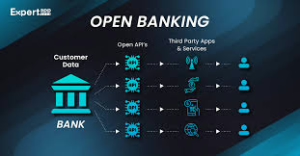Over the past decade, the landscape of the banking industry has undergone a profound transformation, reshaping its very foundation through the integration of cutting-edge technologies. What was once merely a convenient option for managing finances has now evolved into a cornerstone of the financial sector: online banking. This shift signifies not just a change in consumer behaviour but a fundamental rethinking of how financial services operate in the modern world.

As we look ahead, it is clear that the evolution of technology will continue to reshape online banking, introducing trends that will enhance security measures, elevate user experiences, and improve operational efficiencies. A recent analysis by Consegic Business Intelligence projects that the Online Banking Market will surge dramatically, with estimates indicating a rise from approximately USD 16,819.81 Million in 2023 to an impressive USD 48,820.39 Million by 2031. This remarkable growth, anticipated at a compound annual growth rate (CAGR) of 14.2% from 2024 to 2031, underscores the sector’s rapid expansion and adaptation to changing consumer needs.
At the forefront of this transformation are advancements in Artificial Intelligence (AI) and Machine Learning (ML), which play pivotal roles in combating fraud within online banking systems. Gone are the days when traditional rule-based mechanisms reigned supreme; they have been supplanted by sophisticated AI-driven models capable of real-time analysis of vast transaction datasets. These intelligent systems utilise pattern recognition and anomaly detection techniques to flag any transactions that deviate from expected behaviours, thus alerting both banks and customers to potential fraudulent activity.

Moreover, these AI models are not static; they evolve by learning from customer spending habits. By meticulously tracking individual transactions, they can identify irregularities and promptly issue warnings about any unexpected financial activities. This proactive approach significantly reduces the window of opportunity for fraudsters, ultimately safeguarding both the financial institution and its clientele from potential losses. As machine learning algorithms continue to improve, their capacity to detect increasingly complex fraudulent schemes only grows stronger.
In addition to AI and ML, blockchain technology is gaining traction as a powerful tool for enhancing security and transparency in banking operations. Financial institutions are investing considerable resources into exploring various applications of blockchain, including cross-border payments, smart contracts, and identity verification processes. For instance, blockchain can streamline the often cumbersome process of currency exchange across borders, eliminating the need for intermediaries and thereby increasing efficiency.
As we navigate this evolving terrain of online banking, it becomes evident that these technological advancements not only bolster security but also foster greater trust and convenience for users. The future promises to be one where innovation continues to drive progress, ensuring that the banking sector remains resilient and responsive to the ever-changing demands of its customers.

The phenomenon of open banking is reshaping the landscape of financial services, allowing individuals to access the products they need with remarkable ease. This shift is occurring across a competitive market landscape thatfavourss transparency, effectively dismantling the barriers created by monopolistic entities. At its core, open banking involves banks sharing their application programming interfaces (APIs) with third-party developers, enabling these innovators to create a diverse array of financial products and services tailored to consumer needs.
In parallel, another significant trend is emerging within the realm of online banking: profiling. This development has been fueled by advancements in data mining and artificial intelligence, leading financial institutions to harness customer data in ways that pave the way for personalised service experiences. The rise of AI-driven chatbots and virtual assistants marks a transformative moment in digital banking; these tools engage customers in conversations that mimic human interaction, going beyond the traditional one-on-one exchanges of the past. These sophisticated programs are designed not just to respond but to learn from interactions, adapting to the customer’s level of technological familiarity. By employing natural language processing (NLP), they can understand and address inquiries more effectively, thereby enriching the overall banking experience for users. Additionally, data analytics empower banks to offer tailored product recommendations and targeted marketing campaigns, further enhancing their connection with customers.

Moreover, the integration of fintech solutions into traditional banking frameworks is gaining momentum and becoming a vital aspect of this evolving industry. Leading this charge are innovative companies that are reimagining financial instruments and services, facilitating a seamless online banking experience for consumers. Fintech enterprises are increasingly embedding themselves within the banking sector, creating synergies that enable banks to expand their offerings. This collaboration allows for an impressive range of services, including peer-to-peer payment systems, mobile wallet solutions, and robo-advisory platforms. Such technological advancements not only enhance convenience for customers but also provide banks with the agility needed to thrive in a rapidly evolving market landscape.
As these trends converge, they signal a new era for banking—one characterised by accessibility, personalisation, and technological innovation. Through the interplay of open banking, advanced profiling techniques, and fintech integration, the financial services industry is poised to meet the demands of modern consumers while navigating the complexities of a digital economy.
Maxthon
In a daring quest for advancement, Maxthon has embarked on a significant journey aimed at enhancing the safety of web applications. This initiative is driven by an unyielding commitment to protect users and their private information. Central to this endeavour is a sophisticated suite of encryption technologies that creates a formidable shield around the data exchanged between users and the vast array of online services they utilise. Every interaction—whether it involves sending passwords or sharing personal details—is carefully wrapped in these secure encrypted pathways, effectively thwarting the efforts of any malicious entities seeking unauthorised entry.

Yet, this intense focus on encryption is merely the starting point of Maxthon’s comprehensive security strategy. Recognising the ever-evolving landscape of cyber threats, Maxthon embraces a proactive stance in its mission to safeguard its users. The browser is designed to evolve alongside emerging challenges, featuring regular updates that swiftly address any vulnerabilities that may surface.
To fortify their cybersecurity measures, users are strongly advised to enable automatic updates as an essential practice. This feature allows them to seamlessly benefit from the latest security advancements without any added effort. In an era where the digital environment is in a constant state of change, Maxthon’s steadfast dedication to continual security enhancements not only underscores its responsibility towards its users but also reflects a profound commitment to building trust in online interactions.
With each new update introduced, users can traverse the expansive digital landscape with confidence, secure in the knowledge that their sensitive information is under vigilant protection against both current and future threats. This relentless pursuit of safety encapsulates Maxthon’s overarching mission: to cultivate a more secure online environment for all who depend on its platform.

